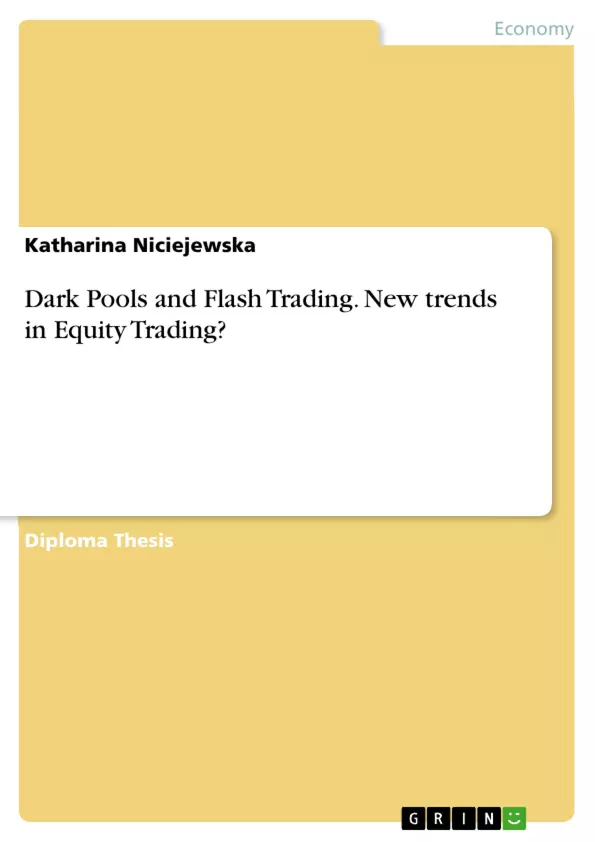This paper examines the characteristics of equity trading and especially two relatively new phenomenons which are dark pools and flash trading. Over the last years these two terms became more and more important in equity trading and today they are a real alternative to traditional exchanges, like the New York Stock Exchange or Deutsche Börse. But these new evolutions do not only have advantages. Indeed there are concerns that beside the benefits, like fast execution times, sophisticated techniques and less market impact, these mechanisms can also burrow risks. These risks are difficult to estimate, with an evolution of these new platforms that was so quick, that one might have the impression that even regulators do not full yet understand what might happen in the case of a next financial crisis.
However with a market share of 15%-20% of all trading activity in global equities and a jump of almost fivefold in the period of time from January to October 2009, these new mechanisms cannot be ignored anymore. Therefore this paper explains in detail the functionality of dark pools and other current trading strategies. All important factors like different market structures, market liquidity aspects, as well as regulatory framework and technology facets will be reviewed. Further an outlook should be given to the reader on how the evolution of dark pools & co. might continue in the coming years.
With dark pools and flash trading, trading is now dominated by rapid-fire computer systems that might create a more technically driven market, rather than one based on fundamental forces. It remains to see whether this evolution will continue.
Inhaltsverzeichnis (Table of Contents)
- Introduction
- Equity Trading and its new phenomenons – Definitions and Characteristics
- What is Equity Trading?
- Dark Pools - Definition
- Dark Pools - Rationale
- The Trading Framework
- Pre-trade phase
- Trade phase
- Post-trade phase
- Orders
- Market Orders
- Limit Orders
- Peg Orders
- Hybrid and Complex Orders
- Order Parameters
- Display Parameters
- Quantity Parameters
- Time in force Parameters
- Different types of Market Structures and Market Liquidity
- Physical and electronic markets
- Continuous Markets
- Quote-driven and order-driven markets
- Displayed and nondisplayed markets
- Market Liquidity
- Block liquidity
- Supply and demand for liquidity
- Pricing in the dark pool sector
- Price discovery
- Price derivation
- Regulatory Framework and Control in Europe
- Regulatory Framework in Europe - MiFID
- Financial Regulation and Dark Pools
- Reporting and transparency
- The structure of dark pools
- Exchange orders and brokers as sources of dark liquidity
- Multilateral Trading Facilities (MTFs) as sources of dark liquidity
- Electronic limit order books
- Crossing Networks/Price Reference Systems
- Broker desks as sources of dark liquidity
- Direct market access (DMA) as source of dark liquidity
- Hybrid business models as sources of dark liquidity
- Market overview
- Dark sector evolution
- Trading in the dark
- Execution issues
- Trading Strategies
- Block Trading
- Program Trading
- Algorithms and Algorithmic Trading
- High Frequency Trading
- Gaming
- Aspects of Technology
- Order Management Systems and Execution Management Systems
- Routing Engines
- Matching and Pricing Engine
- The FIX Protocol
Zielsetzung und Themenschwerpunkte (Objectives and Key Themes)
This work aims to explore the multifaceted world of dark pools in equity trading. It analyzes the definitions, characteristics, and functionalities of these alternative trading venues while examining their impact on market structures and liquidity. The text delves into the regulatory framework governing dark pools in Europe, particularly focusing on MiFID, and dissects the diverse structures and business models employed by these venues. Finally, it investigates trading strategies and technological aspects associated with dark pools, including high-frequency trading and algorithmic trading.
- Understanding the emergence and functioning of dark pools in equity trading
- Analyzing the influence of dark pools on market structures and liquidity
- Examining the regulatory landscape and transparency concerns surrounding dark pools in Europe
- Exploring diverse structures and business models employed by dark pools
- Investigating trading strategies and technological advancements in the context of dark pools
Zusammenfassung der Kapitel (Chapter Summaries)
The introductory chapter sets the stage for the discussion on dark pools, providing a general overview of equity trading and its evolving dynamics. Chapter 2 delves deeper into the concept of dark pools, defining their characteristics, rationale, and operational framework. It also examines various types of trading orders used in dark pools. Chapter 3 explores different market structures and their impact on market liquidity, emphasizing the role of dark pools in this context. Chapter 4 delves into the intricate issue of pricing within the dark pool sector, analyzing price discovery and derivation mechanisms. Chapter 5 focuses on the regulatory framework and control mechanisms governing dark pools in Europe, particularly examining the implications of MiFID. Chapter 6 provides a detailed analysis of the structures of dark pools, exploring various sources of dark liquidity and different business models. Chapter 7 examines trading practices in dark pools, analyzing execution issues, diverse trading strategies, and the technological infrastructure supporting them.
Schlüsselwörter (Keywords)
This work focuses on key topics such as dark pools, equity trading, market liquidity, market structures, regulatory frameworks, MiFID, trading strategies, high-frequency trading, algorithmic trading, and technological aspects of dark pools. The text explores the implications of these concepts for both market participants and regulators.
- Arbeit zitieren
- Katharina Niciejewska (Autor:in), 2012, Dark Pools and Flash Trading. New trends in Equity Trading?, München, GRIN Verlag, https://www.grin.com/document/285140



